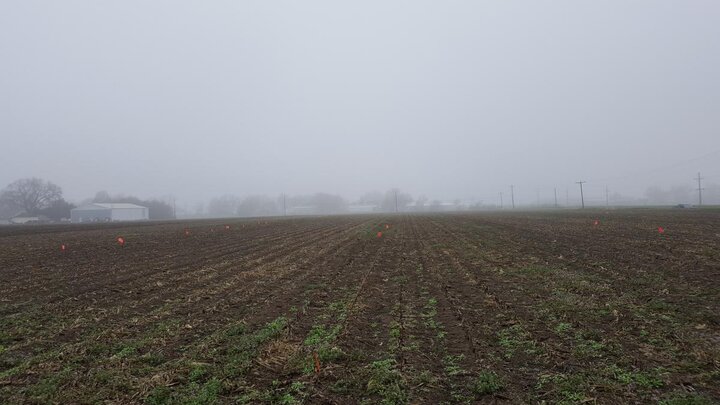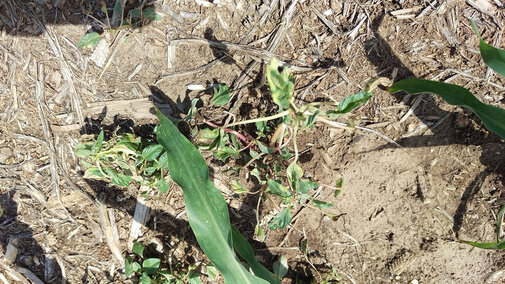Application of dicamba-based herbicides such as Clarity, DiFlexx, DiFlexx DUO, and Status, has increased in corn in recent years primarily for control of glyphosate-resistant and hard-to-control broadleaf weeds such as common waterhemp, Palmer amaranth, and marestail. If you're using dicamba in postemergence herbicide applications, consider these best management practices to help ensure product efficacy and avoid injury to yours or your neighbor's crops.
Best Management Practices with Dicamba
Avoid Using AMS

Use of AMS with the RUP dicamba formulations (XtendiMax®, FeXapan®, and Engenia® herbicides) is prohibited because AMS increases dicamba volatility regardless of the salt formulation applied. This increase in volatility likely contributed to increased soybean injury from dicamba in 2017. For this reason, consider not using AMS with any dicamba application.
In preparing the dicamba application solution use the best quality water possible so minerals do not antagonize with dicamba/glyphosate efficacy. One producer in west central Nebraska is reportedly using reverse osmosis to soften water being used for herbicide applications. Dipotassium phosphate adjuvants listed as one of the new dicamba tank mix partners can be used.
On some plant species, AMS increases glyphosate efficacy even when the spray solution is prepared in distilled water (where no calcium or iron is present) (Bernards 2007). Velvetleaf is a good example of this phenomenon. On velvetleaf, adding AMS to the application increases the amount of glyphosate absorbed by the plant, and/or the amount of glyphosate that moves from the treated leaf to the growing point or roots where it kills the plant. AMS prevents glyphosate from binding to calcium or dirt on the surface of the leaf; the NH4+-glyphosate complex may pass through the waxy layer on the leaf surface better than glyphosate alone.
In research studies, AMS has been shown to have either a positive or neutral effect (common lambsquarters) on glyphosate efficacy, absorption, and translocation. Consequently, when AMS is added at the recommended rates (8.5-17 lbs/100 gal), it will, in most cases, increase glyphosate activity, and should never (or rarely) reduce glyphosate activity.
The glyphosate application rate might be increased to compensate for not including AMS, but should not exceed labeled rates for glyphosate.
Time Irrigation for Product Efficacy
Irrigation or rainfall may help reduce volatility potential of dicamba; however, due to label restrictions, Xtend soybean fields cannot be irrigated up to 24 hours after application of XtendiMax®, FeXapan®, and Engenia®. Corn fields can be irrigated eight hours after dicamba-based corn herbicides (except for the three RUP dicamba products) if volatility is a concern.
As little as 0.04 inches of rainfall or 1000 gallons per acre of irrigation (Table 1) can decrease dicamba volatility. Irrigation is not prohibited on the older dicamba labels (i.e., Clarity) once the rainfast period (four hours after application) is met. Delaying irrigation for at least eight hours allows for increased dicamba efficacy. Irrigation may be beneficial if the forecast is for wind direction to change toward susceptible crops or vegetation. Do not allow any irrigation runoff for off-target issues.
Avoid Successive Dicamba Applications in Corn and Soybean
Because of widespread occurrence of glyphosate-resistant weeds in Nebraska in recent years, the use of dicamba (Clarity, DiFlexx) or products containing dicamba (Status, DiFlexx DUO) has greatly increased in corn. Plan and implement herbicide programs so dicamba is not used successively in corn and Extend soybean. Repeated use of dicamba will increase selection pressure and may result in the evolution of dicamba-resistant weeds.
| Simulated rainfalla (in) | Soybean injury index ratingsb |
|---|---|
| 0 | 36 |
| 0.04 | 5 |
| 0.08 | 3 |
| 0.16 | 5 |
| 0.31 | 3 |
| 0.63 | 1 |
| Check (no dicamba) | 0 |
| Bayes LSD 0.05 | 5 |
|
ASimulated rainfall applied to corn immediately after the dicamba application |
|
Check for Temperature Inversions and Wind Speed
Temperature inversions are an important consideration in spray drift management. The University of Missouri found inversions occurred in at least half of the evenings in Missouri from March to July. The revised XtendiMax®, FeXapan™, and Engenia® labels restrict spraying to sunup to sundown.
A tester, such as SpotOn®, can help you check for inversions. The tool’s temperature sensor is surrounded by a shield that protects it from direct sunlight and other sources of radiation. When held at one meter and three meters above ground and waved for about 20 seconds, this tool can accurately detect temperature readings. If the temperature is higher at three meters than at one meter, there is a temperature inversion and spraying is not recommended.
Also, every sprayer should be equipped with a wind meter. The most convenient to use wind meters are those that work with your smart phone such as the WeatherFlow.

Consider Using the More Restrictive RUP Dicamba Guidelines for All Dicamba Applications
To avoid potential off-target herbicide injury, applicators need to carefully manage all dicamba applications (RUP and non-RUP). Even if applying an older, non-RUP dicamba product, consider following all of the stricter label guideines for applicaton. For all corn, soybean, and other dicamba applications, the revised XtendiMax, FeXapan, and Engenia labels provide great information to reduce off-target injury issues. Following the recommended practices will also increase dicamba effiacy as more herbicide will be on target.
Check the label for any of the RUP-dicamba herbicides for more details on the recommended practices outlined here.
The Nebraska Department of Agriculture Dicamba Information site includes product labels for the three RUP dicamba products:
- DuPont™ FeXapan™ herbicide Plus VaporGrip® Technology
- Engenia® Herbicide
- XtendiMax® with VaporGrip® Technology
- Scout area for susceptible crops and vegetation
- Buffer zone requirement
- Boom height (no greater than 24 inches)
- Nozzle selection and pressure
- Spray volume
- Wind speed (3-10 mph) and direction
- Times of application (sunup to sundown)
- Problems with tank mixing products containing ammonium salts such as ammonium sulfate and urea ammonium nitrate
- Sprayer travel speed (no greater than 15 mph)
- Tank cleaning
More Information
For more information on managing dicamba, see these articles from earlier this year:
- Can We Manage Dicamba Applications in 2018? — includes the best management practices included here plus further information on reducing off-target drift.
- Removing Dicamba Residues from Your Sprayer: A Tricky Task
Reference
Bernards, Mark L. 2007. AMS - What is it Doing in my Tank? 2007 Crop Protection Clinics Proceedings, 123-126.

